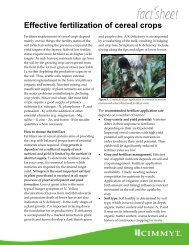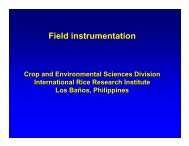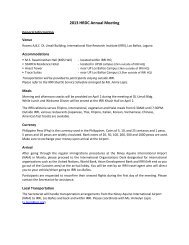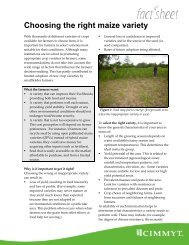Water management in irrigated rice - Rice Knowledge Bank ...
Water management in irrigated rice - Rice Knowledge Bank ...
Water management in irrigated rice - Rice Knowledge Bank ...
- No tags were found...
Create successful ePaper yourself
Turn your PDF publications into a flip-book with our unique Google optimized e-Paper software.
Ponded water depth (mmm)15050Transplant<strong>in</strong>gFlower<strong>in</strong>gHarvest140 160 180–50200 220 240Day number–150–250–350Fig. 3.3. Depth of ponded water on the soil surface (above the horizontal l<strong>in</strong>e) and below the soil surface (below the horizontall<strong>in</strong>e) <strong>in</strong> an AWD experiment, Tuanl<strong>in</strong>, Hubei, Ch<strong>in</strong>a. Adapted from Belder et al (2004).periods of dry soil and impos<strong>in</strong>g a slight droughtstress on the plants, but this usually comes at theexpense of yield loss (Bouman and Tuong 2001).Research <strong>in</strong> more loamy and sandy soils with deepergroundwater tables <strong>in</strong> India and the Philipp<strong>in</strong>esshowed reductions <strong>in</strong> water <strong>in</strong>puts of more than 50%coupled with yield loss of more than 20% comparedwith the flooded check (Sharma et al 2002, S<strong>in</strong>ghet al 2002, Tabbal et al 2002).AWD is a mature technology that has beenwidely adopted <strong>in</strong> Ch<strong>in</strong>a (Li and Barker 2004). Itis also a recommended practice <strong>in</strong> northwest India,and is be<strong>in</strong>g tested by farmers <strong>in</strong> the Philipp<strong>in</strong>es.Figures 3.4 and 3.5 give an example of yields andwater <strong>in</strong>puts obta<strong>in</strong>ed by farmers <strong>in</strong> Central Luzon,Philipp<strong>in</strong>es, who practiced AWD irrigation (Lampayanet al 2005). The farmers used communaldeep-well pumps or their own shallow tubewellpumps to irrigate their fields. They divided theirfields <strong>in</strong>to two, one with AWD <strong>management</strong> and theother with cont<strong>in</strong>uous flood<strong>in</strong>g. Table 3.3 gives aneconomic comparison among AWD and cont<strong>in</strong>uouslyflooded fields. The AWD fields had the sameyield as cont<strong>in</strong>uous flood<strong>in</strong>g, but saved 16–24% <strong>in</strong>water costs and 20–25% <strong>in</strong> production costs.Very little research has been done to quantifythe impact of AWD on the different water outflowsof <strong>rice</strong> fields: evaporation, seepage, and percolation.The little work done so far suggests that AWD<strong>Water</strong> <strong>in</strong>put (mm)1,4001,2001,0008006004002000<strong>Water</strong> <strong>in</strong>put (mm)1,4001,2001,0008006004002000UpperDoloresMiddle2002 2003LowerAverageUpperMiddleLower2002 2003GabaldonAverageDoloresGabaldonAverageAverageFig. 3.4. Total water <strong>in</strong>put (mm) under AWD (shaded columns)and cont<strong>in</strong>uous flood<strong>in</strong>g (black columns) <strong>in</strong> farmers’ fields <strong>in</strong>Tarlac (A) and Nueva Ecija (B), Philipp<strong>in</strong>es, 2002 and 2003dry seasons. Data from Lampayan et al (2005).AB21





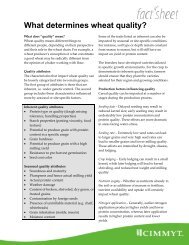

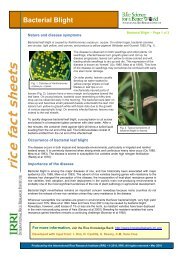

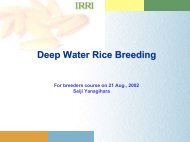
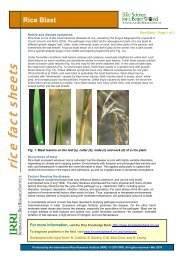
![International Standards' Organization â Rice Specification [ISO 7301]](https://img.yumpu.com/36696862/1/190x245/international-standards-organization-a-rice-specification-iso-7301.jpg?quality=85)

